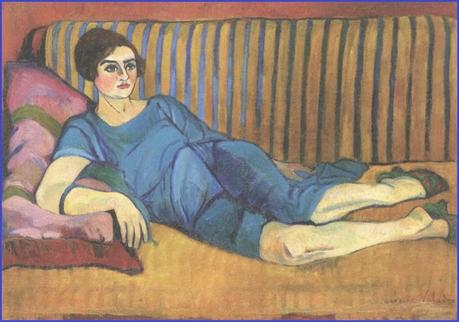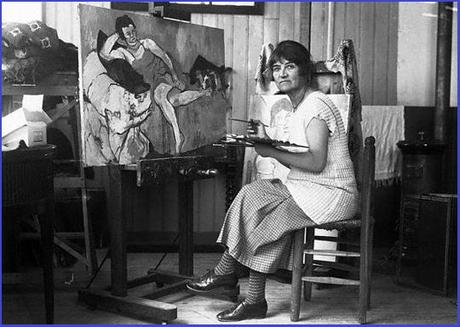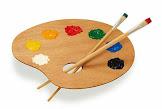Ask me again in a month's time and you'd possibly get a different answer, but it wasn't a random selection. It was almost certainly bound to be a picture by a post-impressionist of the French school, and I figured (as we've recently marked International Women's Day) why not give some much-deserved exposure to the work of a female artist who was creating masterpieces (or mistresspieces) in what was a very male-dominated Montmartre milieu from the 1880s to the 1930s? And Suzanne Valadon's story is a fascinating one.

Woman Reclining On A Sofa by Suzanne Valadon, 1917
She was born out of wedlock to a sewing maid in Limoges (central France) in 1865 and was christened Marie-Clementine Valadon. She never knew who her father was and was raised a single child by a single parent. Her mother relocated them to Paris, looking for work, when the girl was five and they found lodgings in Montmartre at a time when it was still almost a country village on a hill within the city, with its green spaces, windmills and farmyards. Suzanne (as the girl opted to rename herself) was to live in bohemian Montmartre for most of her life.She was a pretty and a precocious child, but that childhood was short-lived. She left school aged eleven to earn a wage, as times were hard, and was apprenticed to a milliner, where she excelled at embroidery and creating imaginative decorations for hats. She also worked part-time as a waitress and in her free time loved to hang out at the cafes and clubs in Montmartre where, with her vivacious manner and good looks, she was soon taken up by the community of artists.
Although she claimed she had been drawing since the age of nine, Suzanne's first serious involvement with the artistic way of life was as a model. By the time she was fifteen, she was in regular demand, posing for Puvis de Chavanne, Renoir, Steinlen and Toulouse-Lautrec among others. Several of the men who painted her also became her lovers and she was still only seventeen when she became pregnant, unsure of who the father was. Following in her own mother's footsteps, she became a single parent when her son Maurice (Utrillo, later a famous painter himself) was born. While grandmother looked after the new-born, Suzanne continued to earn her living as a life model and began her first serious attempts at creating art of her own.
Over the course of a decade from 1883 to 1893 she drew copiously in charcoal and pastel, using her mother, her son, friends and the locale as her subjects and learning by watching the techniques of the men who painted her. As her talents blossomed she began to paint in oils and it wasn't long before her work came to the attention of Edgar Degas, who bought some of her paintings, and who paved the way for her to exhibit her canvases at the National Salon in 1894. She had arrived, and her career as an effectively self-taught artist was underway' albeit with precarious finances.
In 1896 she married "a man of means" and that finally gave her the stability to devote herself full-time to painting: nudes (mostly women), cats (if you like cats, do check them out online), portraits of friends, still life compositions, the pastoral beauty still in evidence around Montmartre village prior to World War I. Her work became increasing vibrant and colourful, and totally original, even anticipating the coming trends of Fauvism and Expressionism.
Alongside all of this, she taught her son to paint and then fell in love with one of his artist friends, twenty years her junior. She divorced her husband in 1909 and moved in with Utter who encouraged and inspired her to take her painting to another level. Her first solo exhibition followed in 1911, she appointed a dealer to sell her works and over the next twenty years she became one of the most eminent painters of the early 20th century, working from her atelier up on the hill in Montmartre.

Suzanne Valadon in her studio
Although she continued to draw in crayon and pastel, it was her colourful oil paintings, a variety of still-life compositions, self-portraits, portraits of friends, more cats and a series of stunning female nudes which deservedly stand as her legacy, to my eyes one of the very greatest of post-impressionist painters and certainly the greatest female artist of her generation.I could have opted for any one of those painting from her most prolific period but I chose 'Woman Reclining On A Sofa ' because its subject-matter, classical composition and relaxed, assured execution seem to epitomise both Suzanne Valadon's aesthetic and her achievement. As she stated near the end of her career in the 1930s: "I have had some great teachers, and I have got the best out of them, in terms of both teaching and example. I have found myself, I made myself what I am, and I think I have said [through my art] what I had to say."
Not One To Be Painted Into A Corner(poem still under construction - tbc soon)

Thanks for reading, have a good week. S ;-) Email ThisBlogThis!Share to TwitterShare to Facebook
